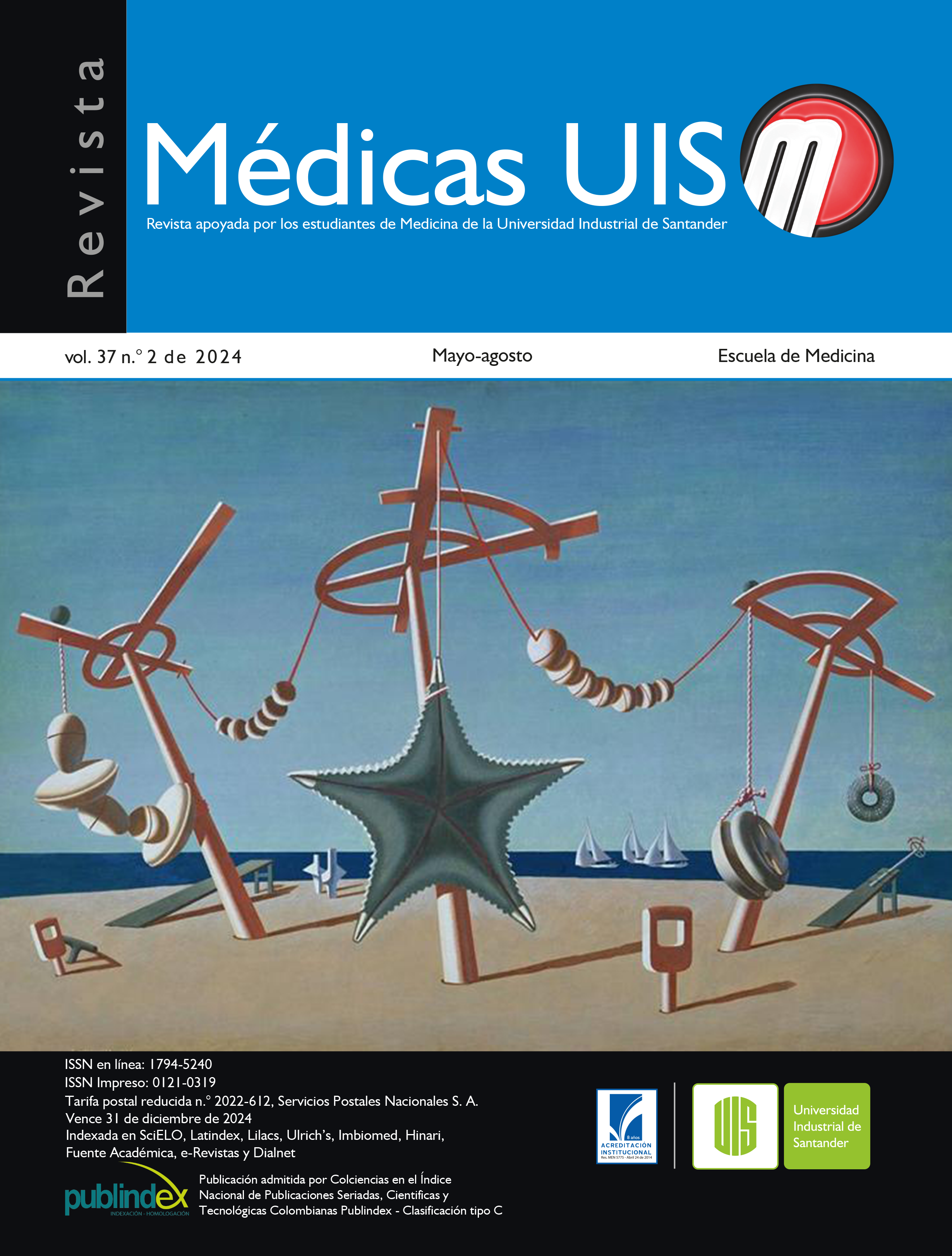Abstract
Introduction: timely diagnosis and treatment of high-grade cervical lesions is crucial to prevent their progression to cancer. In Colombia, cervical cancer ranks fourth in incidence, and despite the implementation of prevention measures such as vaccination, the incidence remains high, even in women under 30 years of age. Objective: to determine the prevalence of high-grade cervical injuries in women aged 30 years or younger who attended a hospital in Popayan between 2010 and 2020, and the epidemiological factors related to these injuries. Materials and methods: cross-sectional study, including all women who had cytological and colposcopic studies and biopsy reports. A form was designed to collect information from medical records. Results: of the 701 women included, 12,27 % had high-grade lesions in histopathology. When analyzing risk factors, it was observed that approximately 33 % of the sample had initiated sexual intercourse by age 14, and 69 % reported having more than 3 sexual partners. Conclusion: detection of high-grade lesions on cytology indicates a greater likelihood of confirming the presence of these lesions on additional studies, such as colposcopy or biopsy. However, a negative cytology does not rule out the existence of cervical lesions.
References
Rodríguez-Cerdeira C, Alba Menéndez A, Bravo Jaso G, Alcántara Cáceres R. El virus del papiloma humano y su repercusión en la patología genital femenina. Piel. 2007;22(4):171-180.
Consuegra Mayor CP, Molina Campo D, Egea Bermejo E, Garavito de Egea G. El virus del papiloma humano (HPV), agente viral importante precursor de la mayoría de las displasias o cáncer cervical. Salud Uninorte. 2004;19:3-13.
Mitra A, Kindinger L, Kalliala I, Smith JR, Paraskevaidis E, Bennett PR, el at. Obstetric complications after treatment of cervical intraepithelial neoplasia. Br J Hosp Med (Lond). 2016;77(8):C124–C127.
Höhn AK, Brambs CE, Hiller GGR, May D, Schmoeckel E, Horn LC. 2020 WHO Classification of Female Genital Tumors. Geburtshilfe Frauenheilkd. 2021;81(10):1145–1153.
Schiffman M, Doorbar J, Wentzensen N, de Sanjosé S, Fakhry C, Monk BJ, et al. Carcinogenic human papillomavirus infection. Nat Rev Dis Primers. 2016;2:16086.
Cancer TODAY. GLOBOCAN: International Agency for Research on Cancer [Internet]. Data visualization tools for exploring the global cancer burden in 2022. 2022. Disponible en: https://gco.iarc.fr/today/online-analysis-multibars?v=2020&mode=cancer&mode_population =countries&population=900&populations=170& key=total&sex=2&cancer=39&type=0&statistic =5&prevalence=0&population_group=0&ages_ group%5B%5D=0&ages_group%5B%5D=13&nb_ items=
Bhatla N, Aoki D, Sharma DN, Sankaranarayanan R. Cancer of the cervix uteri: 2021 update. Int J Gynecol Obstet. 2021;155(Suppl. 1):28–44.
Ministerio de Salud y Protección Social. Guía de práctica clínica (GPC) para la detección y manejo de lesiones precancerosas de cuello uterino. Guía No. GPC 2014 – 44. Bogotá, Colombia;2014. https://www.minsalud.gov.co/sites/rid/Lists/ BibliotecaDigital/RIDE/DE/CA/gpc-lesionesprecancerosas-cuello-uterino-completa.pdf
ZurHausen H. Papillomavirus infections--a major cause of human cancers.Biochim Biophys Acta. 1996;1288(2): F55-78.
Moscicki AB, Ma Y, Wibbelsman C, et al. Risks for cervical intraepithelial neoplasia 3 among adolescents and young women with abnormal cytology. Obstet Gynecol. 2008;112(6):1335-1342.
Diestro-Tejeda MD, Serrano-Velasco M, GómezPastrana Nieto F. Cáncer de cuello uterino:Estado actual de las vacunas frente al virus del papiloma humano (VPH). Oncología (Barc). 2007;30(2):14-31.
Daily LR, Erickson BK, Pasko DN, Straughn JM, Huh WK, Leath CA. High Rates of High-Grade Cervical Dysplasia in High-Risk Young Women With Low-Grade Cervical Cytology. J Low Genit Tract Dis. 2018;22(3):207–211.
Ebisch RMF, Ketelaars PJW, van der Sanden WMH, Schmeink CE, Lenselink CH, Siebers AG, et al. Screening for persistent high-risk HPV infections may be a valuable screening method for young women; A retrospective cohort study. PLoS One. 2018;13(10):e0206219.
Wudtisan J, Tantipalakorn C, Charoenkwan K, Sreshthaputra RA, Srisomboon J. Factors Associated with Development of High-Grade Squamous Intraepithelial Lesions of the Uterine Cervix in Women Younger than 30 Years. Asian Pac J Cancer Prev. 2019;20(4):1031-1036.
Castellsague X, Teixeira JC, Palmroth J, de Carvalho Newton S, Germar MJV, Peters K, et al. Risk of first cervical HPV infection and precancerous lesions after onset of sexual activity: analysis of women in the control arm of the randomized, controlled PATRICIA trial. BMC Infect Dis. 2014;14:551.
Cox J. Epidemiology of cervical intraepithelial neoplasia: the role of human papillomavirus. Baillieres Clin Obstet Gynaecol. 1995;9(1):1–37.
Warren J, Gullett H, King V. Cervical Cancer Screening and Updated Pap Guidelines. Prim Care. 2009;36(1):131–149.
Sasieni P, Castanon A, Cuzick J. The impact of cervical screening on young women: a critical review of the literature 2002–2009. NHSCSP. 2010;31.
De P, Ellison L, Barr R, Semenciw R, Marrett L, Weir H,et al. Canadian adolescents and young adults with cancer: opportunity to improve coordination and level of care. CMAJ. 2011;183(3).
Moon E-K, Park HJ, Oh C-M, Jung K-W, Shin HY, Park BK, et al. Cancer Incidence and Survival among Adolescents and Young Adults in Korea. PLoS ONE. 2014;9(5).
Kylebäck K, Ekeryd-Andalen A, Greppe C, et al. Active expectancy for cervical intraepithelial neoplasia grade 2 in women aged 25 to 30 years: ExCIN2-a prospective clinical multicenter cohort study. Am J Obstet Gynecol. 2022;227(5).

This work is licensed under a Creative Commons Attribution 4.0 International License.
Copyright (c) 2024 Médicas UIS

